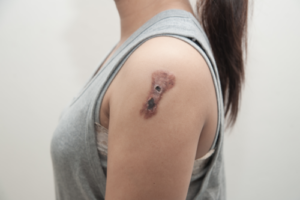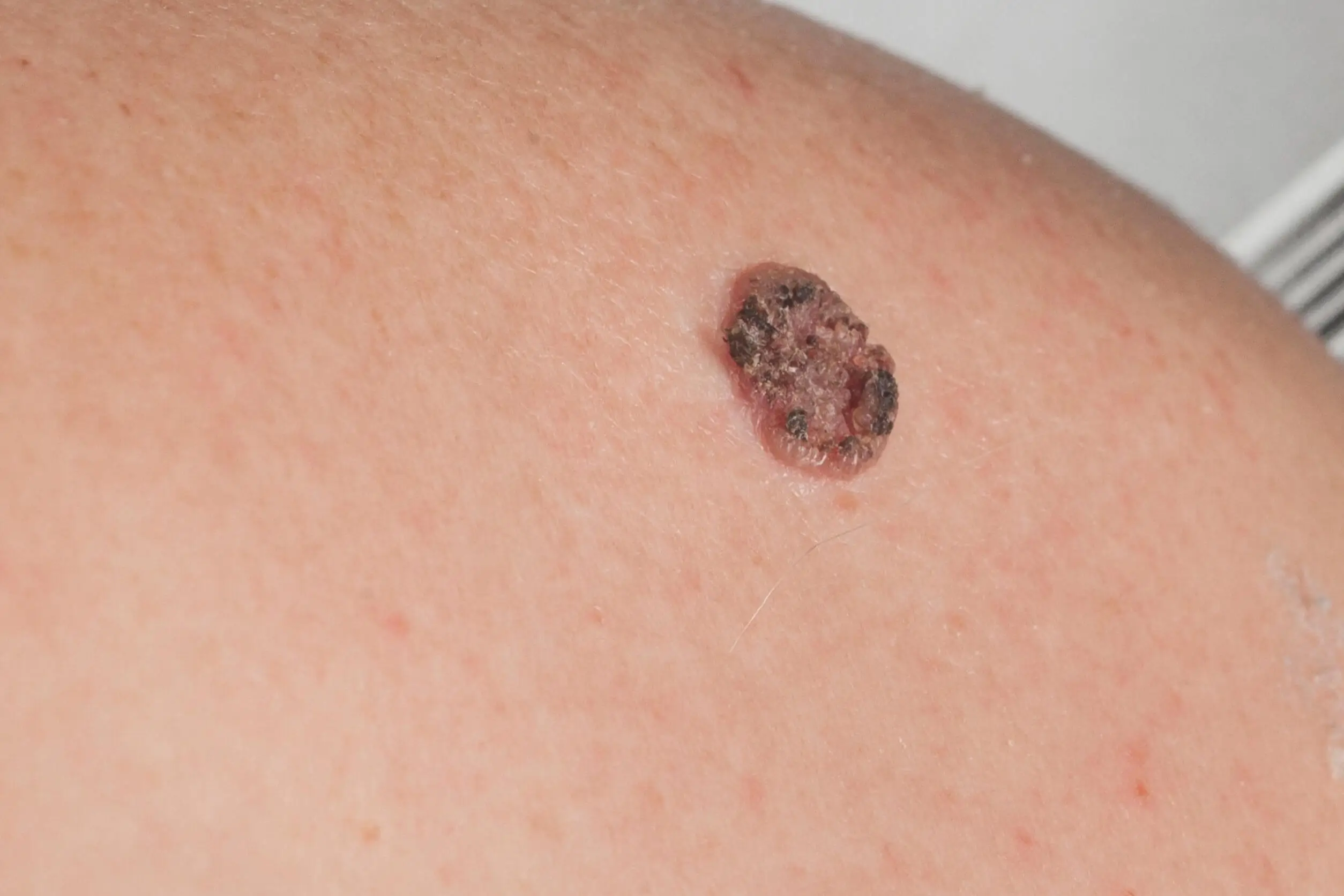Squamous Cell Carcinoma: Causes, Symptoms, and Treatments


Written and verified by the doctor Leonardo Biolatto
Squamous cell carcinoma is a type of cancer that affects the skin. In fact, squamous cells are found in numerous tissues of the body, beyond the skin. For example, they can also be found in the lungs or throat.
However, in this article, we’re going to refer to squamous cell carcinoma of the skin. This is a type of malignant neoplasm that tends to grow slowly, but can deepen and invade other structures.
In most cases, it occurs in connection with sun exposure. This means that prevention is possible.
What is squamous cell carcinoma?
Squamous cell carcinoma (or cutaneous squamous cell carcinoma) is the second most common form of skin cancer. This is explained in an article from the Skin Cancer Foundation. It’s formed from the squamous cells that form part of the middle and outer layer of the skin.
These cells are flattened and undergo continuous renewal. In this way, dead cells are shed from the skin while new ones are formed. Carcinoma occurs when these cells begin to proliferate uncontrollably.
The problem is that they have malignant potential and can invade other structures. In most cases, this cancer isn’t fatal. However, it can damage nearby tissues or metastasize.
Some studies estimate that the incidence of squamous cell cancer in Spain is 38.16 cases per 100,000 inhabitants. Other common forms of skin cancer include basal cell carcinoma and melanoma.
Symptoms of squamous cell carcinoma

In the case of cutaneous carcinoma, as explained by Mayo Clinic specialists, the lesion appears in areas exposed to the sun. For example, it may appear on the lips, face or scalp. It can be a flat sore with a kind of crust on the surface or a firm, reddened nodule.
In addition, it can also take the form of a non-healing ulcer or a raised area on a scar. In the mouth it may look like a rough patch or a reddish sore.
Studies show that the evolution of skin lesions varies from months to years, with slow, progressive growth that gradually invades healthy tissue.
What can cause it?
Most cutaneous squamous cell carcinomas are associated with sun exposure. They’re actually related to ultraviolet (UV) radiation. That’s why they are also more common in people who use tanning lamps or sunbeds.
As an article from the American Academy of Dermathology Association explains, most people affected have fair skin. They also have a history of not protecting their skin with clothing or sunscreen products.
However, there are other cases of squamous cell carcinoma that appear on areas of the skin that are not usually exposed to the sun. For this reason, other factors are suggested to influence its development. For example, immune diseases may do this.
Risk factors
Having fair skin increases the risk of this cancer. In addition, people with light eyes and hair or with many freckles tend to be more prone to suffer from it, especially if they have a tendency to get sunburned.
In fact, having had many sunburns in childhood seems to increase the risk significantly. The same is true if there have been other precancerous lesions on the skin, such as age spots and actinic keratoses.
Research estimates that this type of skin cancer is 2 to 3 times more common in men and appears most often in people over the age of 50. Other risk factors include infections and chronic skin inflammation.
Xeroderma pigmentosum is a rare disease that also increases the likelihood of carcinoma. It’s a pathology that causes extreme sensitivity to sunlight. This is why the damage to the skin is more severe.
We think you may also enjoy reading this article: Ewing’s Sarcoma: Symptoms and Treatments of This Rare Form of Cancer
How is it diagnosed?
The diagnosis of squamous cell carcinoma requires a thorough physical examination. Ideally, the lesion should be examined by a dermatologist. In addition, the physician should know all the patient’s medical history.
However, additional tests are required to reach an accurate diagnosis. A skin biopsy is the most useful way to diagnose it. It consists of removing part or all of the lesion for laboratory examination.
From the biopsy data, it’s possible to identify and classify squamous cell cancer. The new American Joint Committee on Cancer staging system takes into account tumor size, invasion of deep structures, spread to lymph nodes and metastasis to other organs.
Treatments available for squamous cell carcinoma
Treatment of squamous cell carcinoma is variable. It depends on the size of the tumor, its location, or whether it invades any structures.
Treatment if the carcinoma is small
Most cases of squamous cell carcinoma are diagnosed in the early stages. This allows them to be removed with minimally invasive and local methods, especially if the tumor has little or no dissemination.
One of the most commonly used therapies is laser treatment. It’s useful when the lesion is very superficial. It avoids damage to the surrounding tissue and leaves very little scarring.
Another of the simplest techniques is ablation with liquid nitrogen. It’s also called cryosurgery. This is a simple technique that can even be performed in the dermatologist’s office.
Photodynamic therapy seems to be useful in these cases. In addition, curettage and electrodesiccation can be used to remove and seal the base of the tumor.
Treatments for larger tumors
When squamous cell carcinoma is more extensive or deeper, more invasive measures are necessary. Surgery is the most commonly used approach. It consists of removing the damaged skin, making sure to leave tumor-free margins.
However, there are currently other alternatives. One of them is Mohs surgery. This is a procedure that allows the cancerous tissue to be removed in a very specific way, as in layers. At the same time, samples are sent to the laboratory to check whether tumor-free tissue has been reached.
Radiation therapy is also frequently used, especially in cases where there is thought to be a high risk of recurrence.

Treatment of disseminated squamous cell carcinoma
When we speak of dissemination we mean that the tumor has spread to other areas of the body, beyond the skin. In these cases, limited surgical techniques are not curative.
This is why systemic treatments are needed. One of the therapeutic modalities is chemotherapy. Nowadays, drugs that specifically target the tumor can also be used.
Like this article? You may also like to read: Testicular Cancer: The Disease that Borussia Dortmund’s Sebastien Haller Has
Can it be prevented?
Squamous cell carcinoma is often related to ultraviolet radiation. That’s why there are many ways that can help prevent its appearance.
The key is to keep the skin protected from the sun, especially during the hottest hours of the day. At times when there is exposure, sunscreen should always be used. In fact, it’s recommended all year round, regardless of the season.
In addition, sunbeds should be avoided. Another of the basic pillars of prevention is to examine your skin frequently, especially if you have risk factors, such as fair skin.
The most important thing is to always consult a specialist in the event of any abnormal skin growth. Wounds, sores, or ulcers that don’t heal should be examined. The same applies to reddish nodules or warts.
All cited sources were thoroughly reviewed by our team to ensure their quality, reliability, currency, and validity. The bibliography of this article was considered reliable and of academic or scientific accuracy.
- Carcinoma de células escamosas de la piel – Síntomas y causas – Mayo Clinic. (n.d.). Retrieved March 10, 2021, from https://www.mayoclinic.org/es-es/diseases-conditions/squamous-cell-carcinoma/symptoms-causes/syc-20352480
- Tipos de cáncer de piel: descripción general del carcinoma de células escamosas. (n.d.). Retrieved March 10, 2021, from https://www.aad.org/public/diseases/skin-cancer/types/common/scc
- Carcinoma de Células Escamosas – La Fundación de Cáncer de Piel. (n.d.). Retrieved March 10, 2021, from https://cancerdepiel.org/cancer-de-piel/carcinoma-de-celulas-escamosas
- Farasat S, Yu SS, Neel VA, Nehal KS, et al. A new American Joint Committee on Cancer staging system for cutaneous squamous cell carcinoma: creation and rationale for inclusion of tumor (T) characteristics. J Am Acad Dermatol. 2011 Jun;64(6):1051-9.
- Castañeda Gameros P, Eljure Téllez J. El cáncer de piel, un problema actual. Rev. Fac. Med. (Méx.). 2016; 59( 2 ): 6-14.
- Tejera-Vaquerizo A, Descalzo-Gallego MA, Otero-Rivas MM, Posada-García C, et al. Skin Cancer Incidence and Mortality in Spain: A Systematic Review and Meta-Analysis. Actas Dermosifiliogr. 2016 May;107(4):318-28.
- Victoria Bárzaga Héctor Oscar. Carcinoma de células escamosas invasivo diferenciado: presentación de un caso. AMC [Internet]. 2010 Ago [citado 2022 Mayo 26] ; 14( 4 ).
This text is provided for informational purposes only and does not replace consultation with a professional. If in doubt, consult your specialist.








